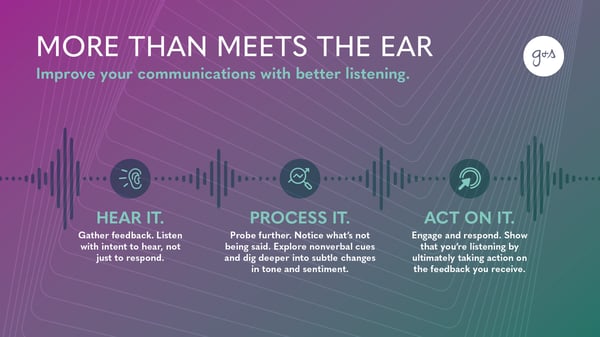The simplest definition of your brand is what your stakeholders think of you. But do you really know what they think?
As marketers and communicators, we often focus on the goal of telling our own story and building a body of content that tells our stakeholders to think about our brand in a certain way. But, as with any relationship, building meaningful relationships with these stakeholders – engaging, nurturing and converting them into customers and advocates for your brand – means engaging in an ongoing conversation with them. And no one enjoys a conversation with someone who only talks about themselves. The best way to engage your audiences in a conversation that leaves them with a positive feeling about your brand is to balance your messaging with effective listening.
Listen More than You Talk
In a widely-circulated article on LinkedIn a few years ago, Sir Richard Branson offers what he calls the best advice he ever received from his father: Listen more than you talk. “I am endlessly surprised by what new and useful information I can gather just by keeping my ears open,” he writes. “If you aren’t listening, you’re missing out.”
Branson talks about the idea of listening as it relates to building personal relationships with colleagues and peers, but the thinking also applies to building relationships with a brand. Listening helps build trust, achieve resonance with multiple stakeholder groups, and ensure that communications in both directions – your messages and your customers’ feedback – are effective and understood by everyone in the conversation.
Listening isn’t just going through the motions of asking for feedback. It’s about identifying nuance in feedback, probing for a deeper understanding, confirming what you hear and showing that you care. Ultimately, it results in connections and stronger relationships with your key stakeholders.

Is Your Brand a Good Listener?
Just as you take the time to craft strong messages and ensure alignment with your overall communications strategy, it’s important to evaluate whether your brand is effectively listening. Here are a few questions to consider.
- How are you monitoring broader societal issues and their impact on your brand? Are you paying attention to what’s going on in the world, and conducting ongoing assessments of whether (or how) your company should respond? Social justice issues, for example, matter now more than ever, and brands can risk appearing tone-deaf if they fail to consider their context and audience before releasing external messages.
You’ll want to track how current events impact your business and which topics your stakeholders care about to inform your communications. For your crisis and reputation management team, it’s important to build triggered alerts and mechanisms to track real-time changes in sentiment and tone on topics that matter to your stakeholders.
- Do you have a continuous feedback loop from customers? It’s an obvious one, but it’s easy for passionate communicators to get excited to talk about the latest product or technology features. What matters most is ensuring those features are aligned with what our customers want to see. Ask yourself: Does the customer get excited in the same way I do?

Listen to customers by testing products and messages on a continuous basis, whether through snap polls, interviews or even a customer advisory board. Creating a customer experience (CX) program can help you capture and respond to ongoing feedback. Building these frameworks not only ensures that messages will resonate but also helps build stronger relationships and connections with customers. Putting in the effort to listen makes your customers feel valued, which leads to greater appreciation for your brand and can lead them to becoming valuable ambassadors.
- Are you paying attention to employees – and competitors? The on-the-ground employees making your business run every day are an extension of your brand, and they can offer a treasure trove of insights about where your business is going, new market opportunities and emerging customer needs. Create mechanisms to engage them in brand building, like anonymous surveys, dedicated committees and one-on-one interviews that allow you to mine their insights for a deeper understanding of your customer.
Competitive audits should also be a regular part of your marketing and communications planning. To stay innovative and differentiate your brand from its competition, maintain a pulse on changing messages and new marketing tactics. Use real-time monitoring platforms to listen deeply for subtle changes in strategy, tone or sentiment so that you can react in real time – or, ideally, faster than your competition.
Listening is just one component of building a strong brand, one that needs to be married with innovative thinking and new ideas. But it’s an important one for making an impact. By embedding active listening into your culture, brand building and communications programs, you can build stronger, more successful relationships with your audiences that translate to greater customer lifetime value.